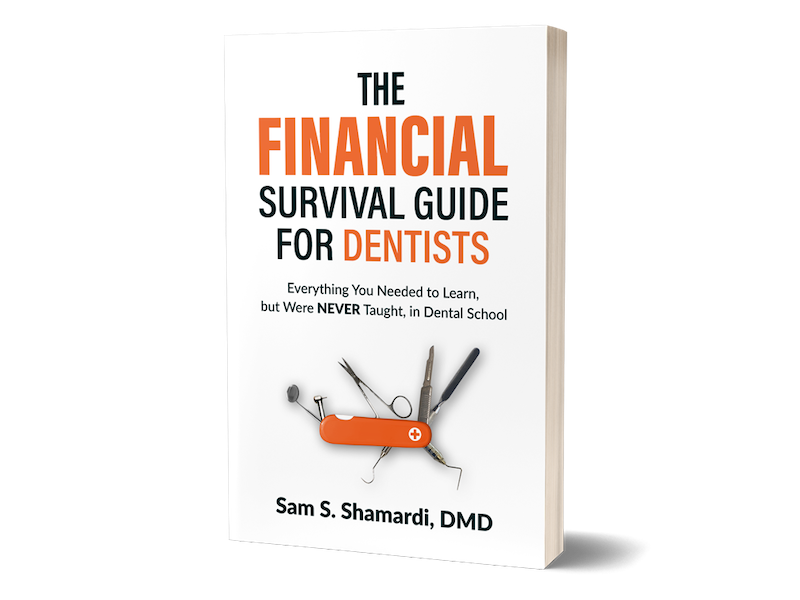
The following section is an excerpt from the book The Financial Survival Guide for Dentists. See the Table of Contents for an overview of the book, or get the book in print or electronic format.
Instead of payments being determined according to your student loan balance and interest rate, the amount due each month is directly connected to your income at the time. The plan takes into consideration income, family size, and location and determines payments as a percentage of your discretionary monthly income, typically 10% to 15%. This calculation depends on when your loans were disbursed.
You may be curious about this term “discretionary income” and in fact, may be wondering when you will have some. Your discretionary income is calculated as the difference between your adjusted gross income and 150 percent of the annual poverty line for a family of your size and in your state.
To qualify, your monthly student loan payments under the IBR plan can’t equal or exceed what your payments would be under the 10-year Standard Repayment Plan.
Federal student loans eligible for IBR include:
- Direct Subsidized and Unsubsidized Loans
- Direct Graduate PLUS loans
- FFEL Consolidation Loans
- Direct Consolidation Loans
Income Contingent Repayment (ICR)
If you have applied for the other plans but were rejected, the Income-Contingent Repayment Plan may be your next best option for reducing your monthly student loan payment. It’s the only IDR plan, for example, for which Parent PLUS Loans are eligible though you will have to consolidate these loans first.
Monthly payments are set as the lesser of either 20% of your discretionary income, or monthly payments when the loan is amortized over 12 years. ICR also offers student loan forgiveness after 25 years.
While there are some major benefits to enrolling in an income-driven repayment plan, there are some potential drawbacks as well that you need to keep in mind.
The repayment period for ICR is 25 years. After that, your remaining loan balance is forgiven (if there’s anything left). However, note that any forgiven debt under ICR is considered to be taxable income. That means even if you do achieve loan forgiveness, you could be facing a steep tax bill in a quarter-century.
Your monthly payment amount under the ICR plan is calculated as the lesser of:
- 20% of discretionary income
- What the payment would be on a fixed, 12-year payment plan, adjusted according to income
Depending on your income, payments could end up higher than with the standard repayment plan. The interest rate for the ICR plan is fixed for the life of your loan. If you first consolidate your loans, your interest rate through ICR is the weighted average of the interest rates on the loans included, rounded up to the nearest one-eighth of 1%.

Pros and Cons of IBR plans
Photo by Josh Appel on Unsplash
Pros of Income-Driven Repayment plans
- Lower monthly payments. If you have low income compared to the amount that you owe in student loans, an IDR can help to make monthly payments more manageable until you can increase your income.
- Adjustable payments depending on the overall situation. Since the monthly payment due is calculated based on income, family size, and location, this amount may change depending upon your current situation. You can ask the lender to recertify your plan when appropriate. If warranted based on circumstances, the amount due may be $0.
- Student loan forgiveness. Based on the type of income-driven repayment plan you qualify for, you may be eligible for student loan forgiveness after 20 to 25 years of on-time payments. Remember that the forgiven balance will be considered taxable income when forgiven.
- Public Service Loan Forgiveness (PSLF). PSLF allows for student loan forgiveness after 10 years of on-time payments. Also, loans forgiven through the PSLF are not considered taxable income and therefore are not taxed. Dentists, dental assistants, and hygienists who work for a nonprofit or public service agency are eligible for this plan.
Cons of Income-Driven Repayment plans
- Longer repayment period. A Standard Repayment Plan takes typically ten years to repay the loan. An IDR plan stretches the payment to 20 or 25 years.
- Taxable income. Any student loan balance that is forgiven is considered taxable income and will come with a very sizable tax bill.
- Higher interest. While lower payments are great for your pocket now, you will be accruing interest over a longer period, increasing the overall amount paid.
- Increased loan balance. In most cases, a reduced monthly payment means that interest is not paid monthly but rather is tacked onto the end of the loan increasing your overall loan balance.
- Documentation. Lenders and financial institutions will automatically send you a Standard Repayment Plan. If you are looking to reduce your payments due to financial difficulty, you will have to apply for IDR plans and recertify your income every year.
- Eligibility. Federal student loan borrowers must qualify for an IDR plan. In some cases, federal student loans must be consolidated for borrowers to qualify for an IDR.
- Income. An IBR plan is determined by a percentage of your income. If 10 percent of your income is higher than your monthly payment on a Standard Repayment Plan, then you may not qualify for an IBR. Loan repayment and IBR eligibility may be determined by your combined household income if you are married. To qualify for any of the Income-Based Repayment plans, you must demonstrate financial hardship, and once eligible, the rates are recalculated every year by the plan servicer.
Practical situation
When considering buying a business or building a practice from scratch, consider applying for an income-based repayment plan as you will already be financially stretched. You can defer monthly payment to keep your overhead to a minimum as you start the practice.
Next section - How you can lose the battle, but win the war: Tactics to repay loans faster
To read more, get The Financial Survival Guide for Dentists from your favorite online or retail bookseller.
Hardcover or e-book format.
Hardcover only.